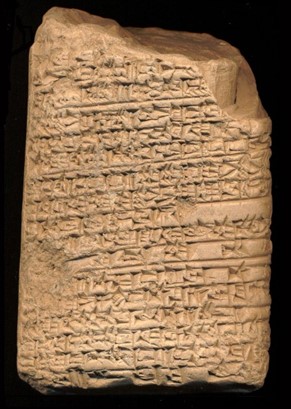Image: Tablet of the Hymn to Ninkasi
East Kingdom Wiki page: https://wiki.eastkingdom.org/index.php?title=Black_Finn_of_Preachain
This beverage is a recreation of a Sumerian ale based on the Hymn to Ninkasi, Goddess of Brewing. The hymn is from Sumer, circa 1800 BCE and serves as both a prayer to the goddess and a chant by which to recall the recipe for brewing ale. There exists no actual known recipe for ale from Sumer, so to approximate the beverage I had to compare the hymn to modern brewing techniques, research the technology available in Sumer at the time, and redact a plausible recipe. My goal with this project was to recreate as accurate a beverage as possible, using the technology of the time, starting only with the hymn as my initial source. Where the translation was unclear I researched and experimented to determine the most logical meaning, based on brewing fundamentals and the technology available in Mesopotamia. I hope you enjoy reading my paper as much as I enjoyed researching and brewing the ale.
Full documentation: https://drive.google.com/file/d/1eri7EI8_rhj_uDBwqrxgb1h4Y2E712L7/view?usp=sharing

I’m thrilled someone out there is just as crazy as Jeff and I. We made this for Birka back in 2015, more for fun than anything, we didn’t panel it, but should have. The flavor was just super interesting, if not refreshing in a way different than I would consider a modern or even medieval beer type.
Keep up the great work, and watch out for shady sellers of mediocre copper in Babylonia.
This is an incredibly cool project, it is such a challenge to research things from such an early period and I love seeing it! Thank you so much for sharing!
That tablet complaining about substandard copper is one of my favorite things. It’s hilarious.
Impressive on so many fronts! Your process is well thought out, and you give a thoughtful analysis of the historical sources and possible trouble-spots with translation or cultural interpretation. You went to lots of extra effort in making and using the appropriate tools and containers for this unique brewing process. And your documentation is quite thorough and full of entertaining details. This is top-tier work in the area of historical brewing. Well done!
What an incredibly cool under taking. I am just learning thevartbof brewing
Well documented and could almost taste the beer,. Thank you.
This is a great and ambitious project. I just wish we could all taste the end result. 🙂
What a great entry! I look forward to someday tasting the practical!
Wow! This is amazing!
I LOVED that this recipe was drawn from a hymn. So much fun. A vivid entry, with interesting historical source material. Now, I just wish I could have a taste.
Brother Finn, I love everything about this project but especially drinking it with friends from the common jug. Nice touch! And congratulations on making the finals. You make your friends and fellow foresters proud!
Wow, what an incredible piece of experimental archeology!! Your research and the creativity of thought here are really inspiring. Also, the photo of the brewer’s guild tasting it warmed my heart ❤️
Wow, Finn! This is freakin’ impressive! I totally just geeked out over it. I loved reading your very thorough documentation, and the pictures of the process were great (also, nice touch with the Noble Dog! 😛 ). I’d really love to try your next batch whenever we can all get together again…I’m so curious about the taste!
I can not begin to tell you how inspiring this type of experimental archaeology is. Thank you.
Wow, great job on the documentation. I really enjoyed reading about your process. Natasha almost stole the show though… 😁